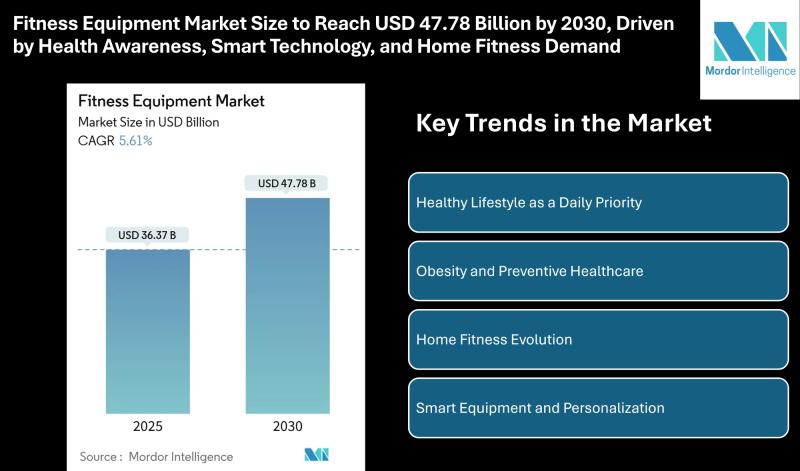The global fitness equipment market is experiencing a significant surge, projected to reach an impressive USD 47.78 billion by 2030. This robust expansion, marked by a compound annual growth rate of 5.61% from its 2025 valuation of USD 36.37 billion, is primarily fueled by a growing worldwide embrace of health and wellness, groundbreaking smart fitness technology, and a sustained demand for convenient home gym solutions. Consumers are increasingly integrating exercise into their daily routines, viewing fitness equipment not as a luxury but as an essential component for long-term well-being and preventive healthcare.
A profound shift towards health consciousness is a key driver behind this market boom. With over a billion people globally affected by obesity and related non-communicable diseases posing substantial economic burdens, there is a heightened recognition of fitness equipment as a vital preventive healthcare tool. Institutions, employers, and even insurers are beginning to subsidize exercise equipment as part of structured health intervention programs, underscoring its pivotal role in combating health challenges and promoting healthier lifestyles across all age groups.
The evolution of home fitness has transformed it from a temporary pandemic-driven alternative into a deeply entrenched preference. Evidence of this enduring trend can be seen in the substantial increase in sports and exercise equipment imports in regions like the UK. This sustained demand for at-home workout equipment is being met by innovations in space-saving designs, seamless smart connectivity, and bundled family offerings, making personal fitness more accessible and convenient than ever before. Many now see home gym solutions as viable, long-term substitutes for traditional commercial gyms.
Technological innovation is profoundly reshaping the consumer fitness landscape, with smart fitness technology leading the charge. The integration of artificial intelligence (AI), the Internet of Things (IoT), and advanced biometric tracking capabilities in modern workout equipment is elevating user expectations. Products offering personalized resistance, guided workouts, and real-time performance feedback are gaining immense traction. Furthermore, the seamless integration with wearables and virtual coaching platforms not only enhances user engagement and retention but also provides equipment companies with invaluable data-driven insights for continuous product development.
Analyzing the fitness equipment market by product type reveals treadmills maintaining a dominant market share due to their versatility and user familiarity. However, strength training equipment is projected to exhibit robust growth, driven by an increasing focus on muscle building, injury prevention, and diverse workout routines. While conventional workout equipment still commands a significant portion of revenue, the demand for smart and connected exercise solutions is rapidly expanding, indicating a clear consumer preference for interactive and data-driven experiences.
Further segmentation highlights critical trends across end-use, price range, and distribution channels. Commercial usage, encompassing gyms, healthcare facilities, and corporate wellness programs, continues to be a major revenue generator. Yet, the residential sector is experiencing rapid expansion, fueled by the desire for convenience and long-term cost benefits of personal fitness solutions. In terms of pricing, mass market products remain widely accessible, while the premium segment is witnessing accelerated growth as affluent buyers seek advanced features and superior performance. Offline retail still dominates sales, but online retail is rapidly gaining ground, supported by improved delivery logistics and enhanced product visualization tools for digital fitness purchases.
Geographically, Europe currently holds the largest market share, benefiting from mature infrastructure and governmental wellness initiatives. However, the Asia-Pacific region is poised to become the fastest-growing market, driven by rising disposable incomes and burgeoning urban health trends that are accelerating the adoption of fitness equipment. The global fitness equipment market remains moderately consolidated, with major players like Technogym S.p.A., Johnson Health Tech, and Life Fitness LLC competing through advanced technology integration, strategic geographic expansion, and the development of comprehensive service ecosystems. Emerging players are also carving out niches, focusing on specialized segments such as eco-friendly equipment and AI-powered platforms.
In conclusion, the global fitness equipment market is undeniably on a strong upward trajectory, propelled by a collective global commitment to health and wellness, ongoing efforts to combat obesity, and the continuous innovation in connected, at-home fitness solutions. As more individuals embed physical activity into their daily lives, the demand for smart, convenient, and highly effective workout equipment will only continue to escalate. The future of fitness appears to be a dynamic hybrid model, where traditional gym experiences complement the increasing appeal of personalized home setups, digital coaching, and advanced data tracking. Brands that can master the fusion of quality, technological innovation, and accessibility are best positioned to thrive in this evolving market where health is no longer a choice but a daily imperative.






Leave a Reply